
August is not
the month one would chose to visit Morocco, but when Eitan was to be an
official at the World Bridge Championships, we went. And it is hot, 46°C on our first day.
The other thing
to know it is a little like being in Sinai, throw away your watch
because time
is slower here; registering at a hotel takes ages. But everyone is so
pleasant
after the initial annoyance everything is just fine. On arriving late
at the Movenpick
hotel in Marrakesh we wanted something to eat. Our cokes were served
with
delicious, not salty olives. No nuts but the waitress brought us three
breadsticks which was just enough to tide us over.

Arriving at the
Movenpick Hotel initially was a little unsettling. A string of cars
blocked
the
entrance to the hotel and no bellboys were in sight, so we had to drag
our
suitcases
up some stairs, walk along an elaborate approach, but
couldn’t find
the entrance to the hotel.
Just continue, we were told and, "open sesame",
huge
embellished doors swung open after which we had to find the reception.
When we
returned from Fes, we were in the know.
Each town has taxis of a different colour – Fes is red, Marrakech mustard-yellow, Rabat is blue – and from my experience, all will try and double the price for tourists.
Morocco generally and Marrakech especially is very
clean. Boulevards with lighting and greenery on the divides line the
main
streets. The cars we saw looked well kept. There are of eating places
along the
way.
Breakfast is a jolly affair at the Movenpick hotel;
the eating area is either outside under olives trees or with the food
inside and
air conditioned. The spread was varied and tasty. It was also nice to
greet
people we knew and even people we didn’t know from countries taking
part in the
Championships, as far away as China and Japan, South America, the
Caribbean and
from African countries.
JARDIN MAJORELLE
It is very hot
and I had no plans to leave the hotel, but the concierge said it was
the last
day to see the Berber museum at Jardin Majorelle and I should go. What
a lovely
visit.
On entering you
walk around a cactus garden, containing some 300 fascinating cacti from
the
Americas, groves of bamboo, palms and bougainvillea, with ponds of
water.
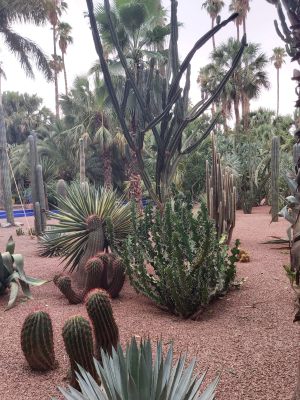
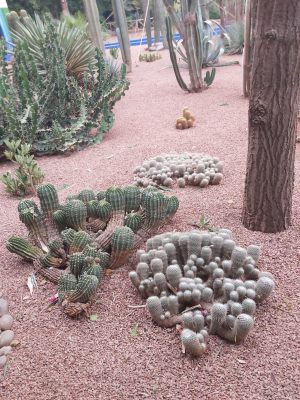
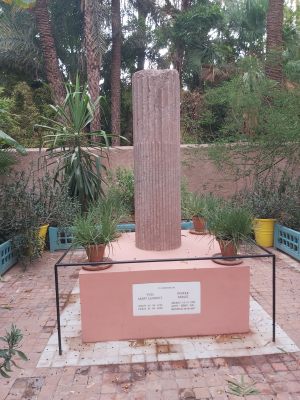
Jacque
Majorelle, a French artist, is best known for these gardens, which are
famous here
in Marrakesh. The building are
in Majorelle blue, made from cobalt,
reminding
us of Chefchauoen. After his death the gardens were neglected until
Yves Saint
Laurent and his partner Pierre Berbe bought and restored the gardens
in 1980.
In the garden there
is a memorial to them both – a piece of a Roman column they found on
the beach
in Tangier.
Entry into the Berber
Museum is highly supervised and unfortunately no pictures are allowed.
The
Berbers or Amazigh
as they call themselves are nomadic people from
Maghreb. The
museum displays their material culture, everyday objects
beautifully of
decorated
leather, metal, ceramic, wood and silver. But it was the women’s
jewelry, huge
pieces of amber,
red coral and worked silver that were the most
impressive. One
showcase had both Islamic and Jewish ritual articles.
Yves Saint
Laurent, although born in Oran Algeria, found inspiration in Marrakesh,
in its
light and colour, where he often
went to design his clothes. He and
Pierre bought
a house next to Jardin Majorelle, which later became a museum,
showcasing
Yves’
designs. Again no photos. Many sketches and clothes, some of them
outrageous as
well as a short movie of his life.
Even if you are not a designer, it
was very
interesting.
Having experience
with taxi drivers here I asked how much it cost to go back to the
hotel, before
I got in. Yes, they are renowned for overpricing and good thing I
remembered
how much I paid getting there and after bargaining, paid the same price
going back.
--------------------------
We were invited to the President’s Dinner at a delightful
venue, the Beldi Country Club. The ride there took so long we wondered
not only
if we were still in Marrakech but also in Morocco. Beautiful gardens,
candle-lit seating spaces, wood fires to light the way and a lovely
eating area
below beautiful chandeliers in a room open on all sides. We sat at a
table with
representatives from Jordan, South Africa and England, The food was
typically
Moroccan: salads, tajines, couscous and jawhara for dessert. The only
downside
was that it was very hot without a breeze. The other eating places
we’ve been
to so
far, if they are outside, have sprays of water to cool the diners.
On the way back to the
hotel, late at night, all the spaces
outside, wide pavements, gardens, and divides between the streets were
crowded
with people sitting on chairs and eating or just on mats on the grass
with kids
running around and vendors peddling their stuff. It all looked very
jolly. It
reminded me of Israel on Independence Day without the mangals/barbecue.
After
buying a tajine in Fes and on the recommendation of a friend,
I signed up for a cooking class on tajine cooking. The concierge wrote
down
the address of the hotel and said I should pay the taxi 50 Dirham. The
taxis outside wanted
100 Dirham and when I refused, he called over another man who would
take me
for 50 Dirham. Well pleased with myself, I followed him to his taxi.
Off he
drove and after a time he stopped. "Where’s Riad Manceau?" I asked. He
waved airily in the direction
of a somewhat seedy looking alley and wanted me to get off. “Don’t you have a map?” he asked. I did and I
also knew the general area of the hotel. I
gave him my map and asked him to show me where
he was dropping me off. He had no idea where to find it on the map. I
got out and started walking. Half an
hour later, asking about 15 people for directions and nearly stepping
on the snake charmer's snake in the main square, some-one helped me
find the hotel on
Google maps. It seems that
half price was also half the distance! But at no time did I feel
threatened or
uncomfortable. Just hot.
The hotel
Riad Manceau was down a small alley and simple enough.
Gasping I asked for a bottle of water and was taken to a large room
with a
stove an oven and a large table with settings for 3 people in addition
to the instructor. There was no
air conditioner and it was very hot. Spices, meat, and chicken were all
prepared.
I had asked to make chicken and vegetables in the tajine but was told
it was a
sweet dish and if I wanted not sweet I would have to prepare lamb. The
two
young women from France were vegetarian, so vegetables were happily to
come. The
instructor showed us in what order to
prepare the ingredients and place them in the tajine.
The vegetarians got a wedge of cabbage to put
in the tajine and I got lamb bone with a little meat.
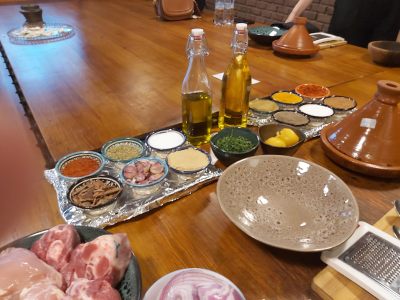
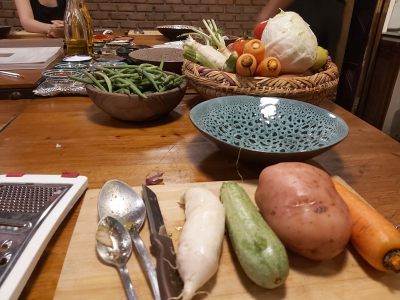
While the
tajine was cooking we prepared Vegetable Mhancha with a
tomato sauce. After they were cooked she brought in paper thin leaves
of pastry
which we filled and rolled and then turned into a spiral. This was
placed in
the oven to bake. Cooking class over.
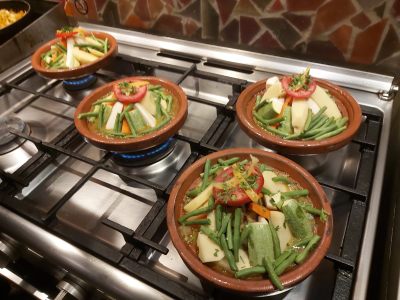

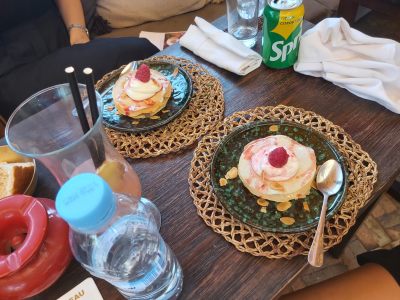
We made
our way to the terrace – more stairs, no elevator – and
waited until our food was ready and brought upstairs. I think if it was
cooler
I may have enjoyed the food more. The dessert, which we didn’t make,
was
delicious – Jawhara - layers of paper thin pastry filled with cream.
Another dinner we
enjoyed was the Executive dinner
at Dar Rhizlane. Music was provided by an oud player and a percussion
player.
We were delighted when they began to move their heads with their Fez
hats so that the
tassels swung around. Our attempts weren’t as expert as theirs.
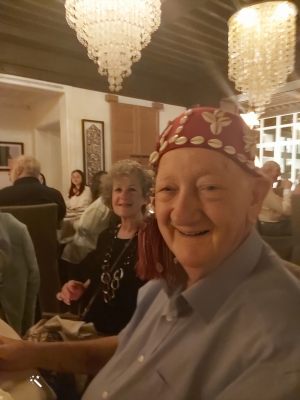
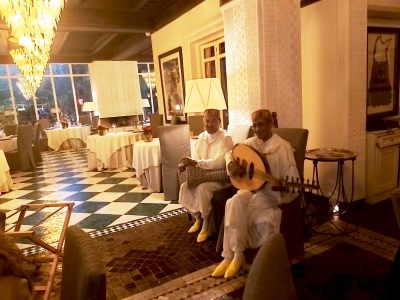
The WBF staff dinner
was at Safran in the old city.
It was a lively affair with continuous loud music, belly dancers,
acrobats,
drummers and lots of food and wine. Definitely the best staff dinner
I’ve been
to.
Click on the picture
below to see a video of some of the fun.
Eitan and I went to a
fancy restaurant Le Loft.
Eitan was delighted when his marrow bones and toast arrived. We are
used to
bones that you have to suck the marrow out. This he could eat with a
spoon. I
had snails, remembering how Moran used to love them. My French friend
Cendrine
told me many years ago that it was quite alright to eat the big snails
we found
in our garden, just give them a week’s diet of lettuce. Moran and I
decided
we’d stick to the restaurant ones.
Mark Horton invited a
few friends to have dinner
with him at another fancy French restaurant, Luma, a short walk from
the hotel. We were a bit wary as
his last
‘short walk to the restaurant’ in Madeira was 40 minutes walk away. Fortunately Luma was close by and we
enjoyed a delicious meal
with much
talk about wines, grandchildren and old friends.
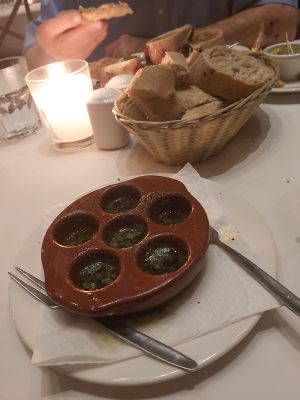
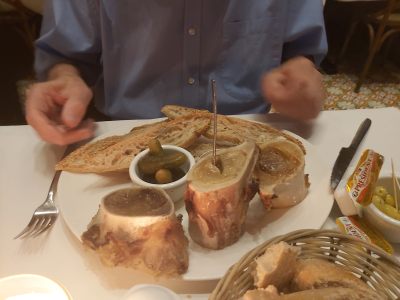
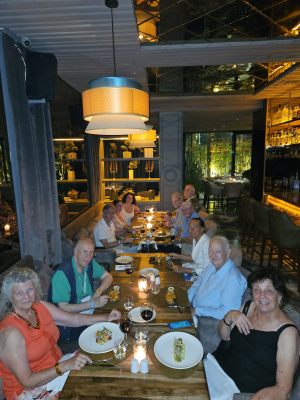
Walking tour of Marrakech:
I was delighted
when Marina Media joined me on a walking tour of historical Marrakech.
After my
bad experience in trying to find my cooking class, I asked Saaid, one
of the
greeters at the hotel entrance to come with me to the taxi driver who
promised to
drop us off right in front of our meeting point at Cafe de France in
Jamaa el-Fnn,
the large central square. People
here are very
friendly and welcoming especially when they heard we were from Israel.
Most
people speak Moroccan Arabic and French and quite a lot speak English,
which they only learn in high school. So
it came as quite a surprise that in the souks many speak fluent Italian
and Spanish.
Abdu was our
guide. At a fast pace he led us to our first stop .I would have liked
less
history and a more leisurely pace with time to peer into the
fascinating shops
on the way.
We paid the
entrance fee to the Bahia Palace. Built in 1867 by the Grand Vizier Si
Moussa,
it was a beautiful place with meeting rooms to conduct business; some
had
fireplaces, a French addition. The Vizier had 4 wives and the chief one
was
Bahia, who gave him an heir and after whom the palace was named. Each
room was
delicately embellished with painted cedar ceilings, intricately carved
stucco
on the walls and zellige tiles on the floor. An Andalusian garden
filled a
courtyard with different fruit trees and flowers. The Vizier also had
24
concubines, but only had 12 simpler rooms for them!
As we walked to
the Mellah, the old Jewish quarter, we quickly admired designs of
potpourri
enticing people to enter the stores. I suddenly heard the sound of a
shofar. Standing in the tiny entrance to a shop was a man with a black
kippa
blowing a small shofar. Abdu told me he was a barber. Note the
old-style gazoz
(soda) bottle in his window. A door supposedly leading to the oldest
synagogue
in Marrakech was closed and looked much neglected.
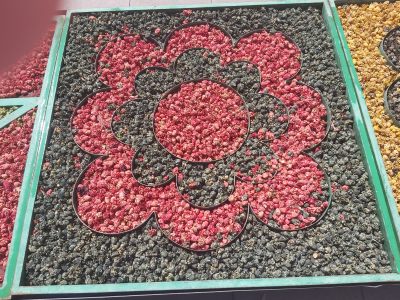
Reaching the
Kasbah we entered the Saadian Tombs which were adjacent to the kasbah
mosque.
The Saadian Dynasty ruled Morocco in the C16. Sultan Ahmad al-Mansour
designed
this necropolis to honour his ancestors and display his power and
wealth. Many
members of his dynasty are buried in beautiful structures. Outside
among the rose
gardens there are mosaics covering what are believed to be from the
next
dynasty, the Alawi. There are 56 tombstones with names and about a
hundred
tombs marked by multi-coloured mosaics. We also saw tortoises walking
in the
rose garden.
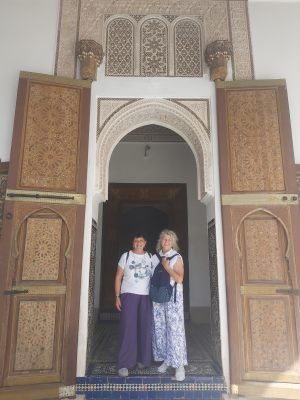

After returning
to our starting point, Marina and I wandered around part of the souk.
It being
Friday, many places were closed, i.e a cardboard over the goods when
the owner
went to pray, and we determined to return the next day, which we did.
What fun it was. It seems that the shopkeepers have many Italian tourists because they chatted to Marina in Italian and to me in English. We first stopped at a leather shop where Omar a charming nomad from the Sahara Desert helped us chose purses and shoes while treating us to mint tea and fixing Marina’s sandal. When he heard we wanted spices he took us to his relative a few shops away. I bought the most fragrant sweet paprika ever and declined argan oil, again.
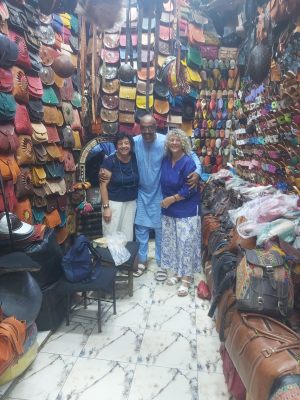
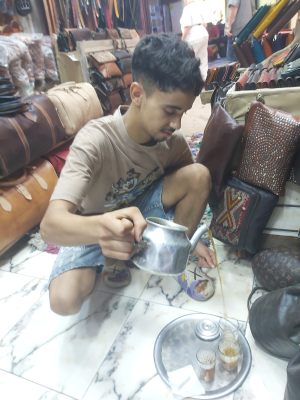

Marina then
wanted to go to Madrasa ben Youssef. We had some difficulty finding the
Madrasa
and ended up following a man who led us down a quiet alley. Feeling
uncomfortable, I refused to follow him any longer. Good thing, we were
told he
wanted to take us to the mosque. Why would he because non-Moslems are
not
allowed into mosques; the only one is the Hassan II in Casablanca. We
found
signs to the Madrasa and it was a good visit. Previously an Islamic
college
built in the C14 it was eventually abandoned in the C18. It has been
restored
and is a beautiful site for tourists and Moroccans alike. Everywhere
there is
intricately carved stucco and colourful mosaics .

Marina? Juliet?
It was
surprising
when a little boy and then his sister came up to me to be hugged. I
would never
dream of touching a strange child today, but this was a delightful
surprise.
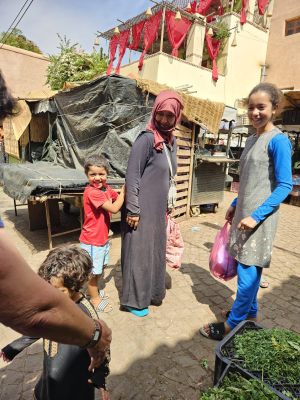
After spending
about 5 hours in the souks, I wanted to return to our hotel while
Marina went
to the monthly Berber market.
---------------------
We were delighted that
the Israeli women won the Venice Cup, the most prestigious women's
event
in the bridge world. Eitan was happy to help award the medals.
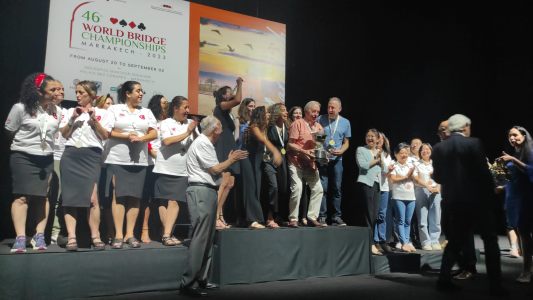
The next day,
with the bridge competitions over, it was Eitan’s first free day. After
a
leisurely breakfast we took a taxi to Café de France from
where I could
orientate myself. We strolled along alleys looking at the myriad of
shops, no
bigger than a hole in the wall. The shops offering nuts and dates had a
tiny
door below the offered goods where the owner crawled through and came
out in
the middle of his shop. Far away from the front edge of his shop, with
a scoop
on a long stick he gave the shoppers the things they had bought. We
bought the
spice ras el hanout, almost as ubiquitous as argan oil. When we came to
a part
of the souk that was unpaved we turned around and entered another
alley. With
the alley thronged with people one would think bumping into someone was
the
only hazard, but there was a constant stream of bicycle riders, hand
drawn
carts and men whizzing around on vespa scooters who dodged between the
pedestrians.
Now amazing displays of different coloured olives were on display
between
bottles of pickled lemons and onions and other delicious looking but
not quite
decipherable things.
We found ourselves at the
spice shop where I
had visited yesterday. With other women we waited on a bench until we
were
served. We continued to the leather shop to meet Omar the charismatic
nomad
from yesterday selling leather goods. I was delighted when Eitan
refused the 500
camels Omar offered for me.

A little gem of the
Movenpick hotel was that every day
between 5 o’clock and 6 an array of
chocolates was laid out for guests and staff to enjoy. Thank goodness I
only
knew about it a few days ago because they were delicious.

On our last day, after
we had packed I wanted to
return to the big square and buy something. The taxi driver couldn’t
believe I
hadn’t been to the Jewish spice shop. He talked so much about it that I
asked
him to drop me off there. It was an immaculate shop displaying creams
and
spices, but most impressive was that the shop assistants (not Israelis)
all
spoke Hebrew. Sadly I needed nothing from the shop.
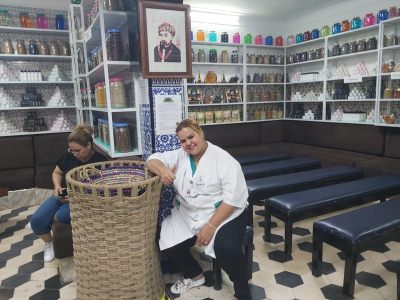
A few doors away
was an
amazing shop displaying fossilized ammonites outside and exquisite
trilobites inside.
If we come again as planned this is certainly an area to visit. I bought an
interesting combination of pants and half skirt for
one of my granddaughters and then needed a detailed explanation on how
to
assemble it. What fun. The way to Café
De France was through an area where
Moroccans shop,
offering mainly clothes, electronic things and eating places based
mainly on
fried pastries. Crossing
the big
square again passing the snake charmers
playing the pungi, a type of
flute and metal clappers. It seems that snakes don’t have ears but are
reacting
to vibrations and the movements of the snake charmer.
I walked through the
souk until I found the two
shops I hadn’t photographed yesterday – the stalls selling nuts and
dates and
the other stalls selling olives.
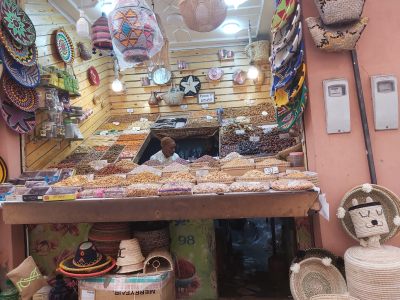
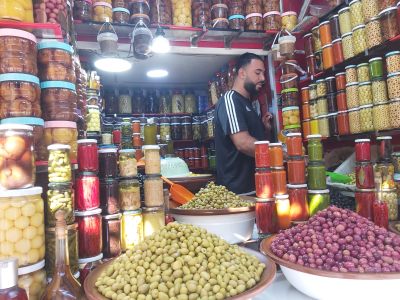
Go to Eitan and Doreen's Home Page